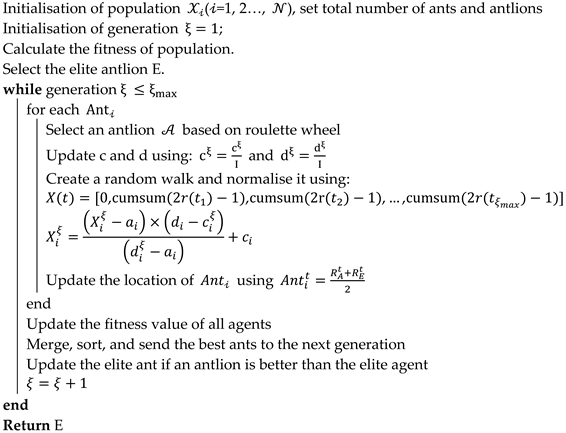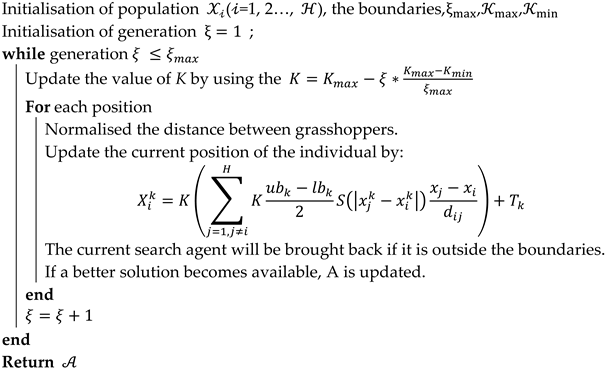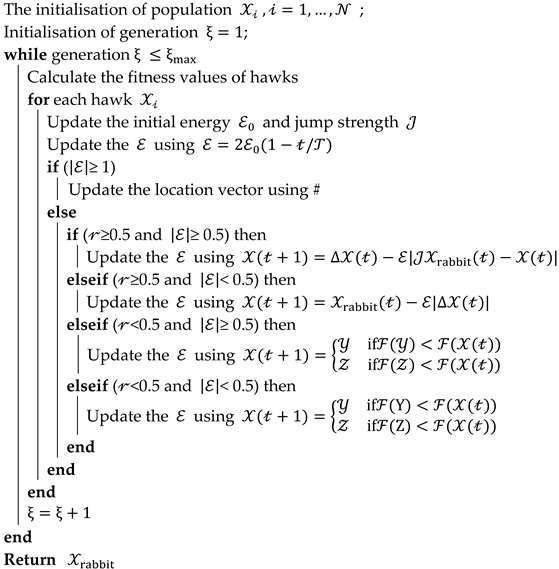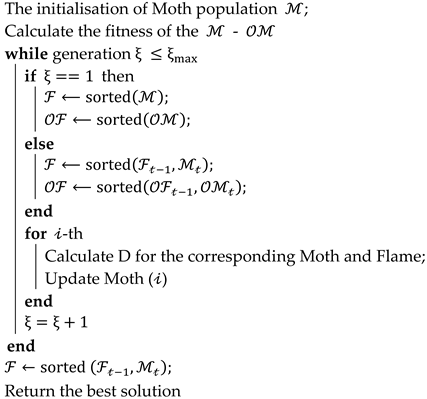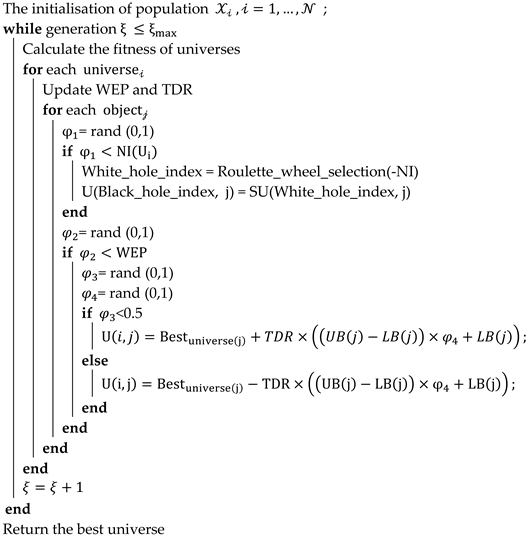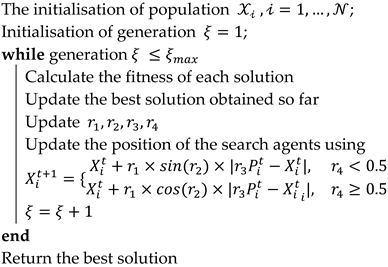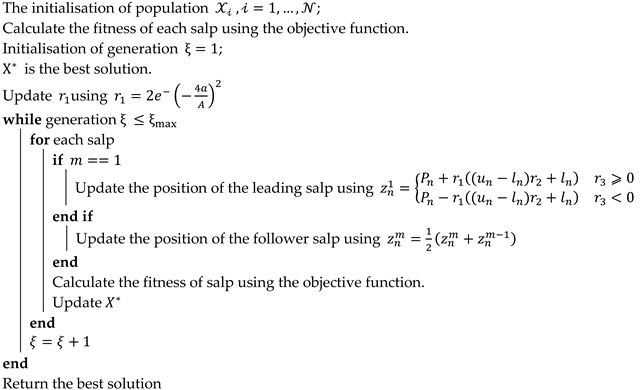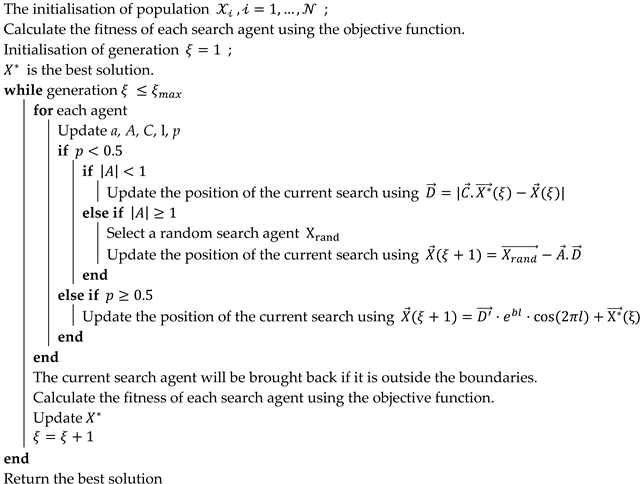Attracting Potential Customers in E-Commerce Environments: A Comparative Study of Metaheuristic Algorithms
Abstract
1. Introduction
- (1)
- Investigating the existing studies in e-commerce environments, particularly those that addressed the website design for attracting customers in e-commerce environments using decision-making techniques.
- (2)
- Evaluating the accuracy and robustness of the metaheuristic algorithms as an optimisation tool in the website design process.
- (1)
- What are the limitations of the existing approaches for an effective website design for attracting customers in e-commerce environments?
- (2)
- How are the robustness and accuracy of metaheuristic algorithms in finding appropriate decisions for website design to attract potential customers in e-commerce environments?
2. Literature Review
3. Problem Statement
| Set of customers, | |
| Set of websites, | |
| Set of websites, | |
| Set of screens in website , | |
| Size of screen | |
| Set of potential size for advertising, | |
| Interest of customer to product if it is advertised in screen and at size | |
| Minimum customer interest threshold | |
| A big number | |
| Available budget | |
| Cost of advertising product in website in screen and at size | |
| Binary variable that equals 1 if product is advertised in website in screen and at size , else 0, | |
| Binary variable that equals 1 if customer is covered by website , else 0, | |
| Binary variable that equals 1 if customer is covered, else 0, |
4. Review of Metaheuristic Algorithms
4.1. Concepts of Metaheuristic Algorithms
| Algorithm1. A Generic Metaheuristic Framework. |
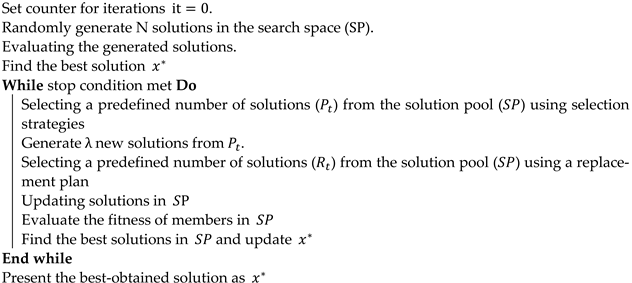 |
4.2. Classification of Metaheuristic Techniques
- Deterministic versus stochastic methods: Deterministic methods follow a definite trajectory from the random initial solution(s). Therefore, they are sometimes referred to as trajectory methods. Stochastic methods (discontinuous methods) allow probabilistic jumps from the current solution(s) to the next.
- Greedy versus non-greedy methods: Greedy algorithms usually search in the neighbourhood of the current solution and immediately move to a better solution when it is found. This behaviour often leads to a local optimum. Non-greedy methods either hold out for some iterations before updating the solution(s) or have a mechanism to backtrack from a local optimum. However, for convex problems, greedy behaviour is the optimum strategy.
- Memory usage versus memoryless methods: Memory-based methods record past solutions and their trajectories and use them to direct search.
- One versus various neighbourhood methods: Some metaheuristics, such as simulated annealing and tabu search, only allow a limited set of moves from the current solution. However, many metaheuristics employ operators and parameters to allow multiple neighbourhoods. For example, particle swarm optimisation achieves this through various swarm topologies.
- Dynamic versus static objective function: Metaheuristics that update the objective function depending on the current search requirements are classified as dynamic. Other metaheuristics use their operators to control search.
4.3. Metaheuristic Algorithms Used in This Study
- Ant Lion Optimiser (ALO) [44] is a recent metaheuristic that mathematically models the interaction of ants and antlions in nature. An optimisation algorithm has been developed to solve the optimisation problems that take into account random ant walk, building traps, entrapment of ants in traps, catching prey, and re-building traps [88]. The pseudocode of ALO is presented in Algorithm 2.
Algorithm2. Ant Lion Optimiser (ALO). - Dragonfly Algorithm (DA) [45] is primarily inspired by static and dynamic swarming behaviours. These two swarming behaviours are very similar to the two main phases of metaheuristic optimisation, which are exploration and exploitation. The main goal of the exploration phase is for the dragonflies to form subswarms and fly over different areas in a static swarm. The dragonflies in the static swarm, on the other hand, fly in larger swarms and in one direction, which is advantageous during the exploitation phase. The pseudocode of DA is presented in Algorithm 3.
Algorithm3. Dragonfly Algorithm (DA). - Grasshopper Optimisation Algorithm (GOA) was proposed by Saremi, Mirjalili and Lewis [46], which is a metaheuristic optimisation method and is inspired by the group behaviour of grasshoppers. This method imitates and simulates the behaviour of grasshoppers in nature and their group movement towards food sources [65]. The capability of GOA in tackling complex problems has been proven by numerous studies [89,90,91]. The pseudocode of MFO is presented in Algorithm 4.
Algorithm4. Grasshopper Optimisation Algorithm (GOA). - Harris hawks optimisation (HHO) [47] is a swarm-based optimisation method. HHO’s main concept is to mimic the action and reaction of a hawk’s team collaboration hunting in nature and prey escaping to discover solutions to the single-objective problem. The pseudocode of HHO is presented in Algorithm 5.
Algorithm5. Harris hawks optimisation (HHO). - Moth-flame optimisation algorithm (MFO) [48] assumes that the candidate solutions are moths and that the variables of the problem are the positions of the moths in space. Both moths and flames are viable solutions. The distinction is in how we treat and update them in each iteration. The moths are actual search agents that move around the search space, whereas the flames are the best position of the moths that have so far been obtained. In other words, the flames can be thought of as flags or pins that the moths drop while searching the search space. As a result, each moth searches for a flag (flame) and updates it if a better solution is discovered. A moth’s best solution is never lost with this mechanism. The pseudocode of MFO is presented in Algorithm 6.
Algorithm6. Moth-flame optimisation algorithm (MFO). - Multi-verse optimiser (MVO) [49] is inspired by three cosmological concepts, including white holes, black holes, and wormholes. These three concepts’ mathematical models are created to perform exploration, exploitation, and local search, in that order. The pseudocode of MVO is presented in Algorithm 7.
Algorithm7. Multi-verse optimiser (MVO). - Sine Cosine Algorithm (SCA) [50] is an optimisation technique used to solve optimisation problems. Using a mathematical model based on sine and cosine functions, the SCA generates multiple initial random candidate solutions and requires them to fluctuate outwards or towards the best solution. Several random and adaptive variables are also integrated into this algorithm in order to emphasise exploration and exploitation of the search space at various optimisation milestones. The pseudocode of SCA is presented in Algorithm 8.
Algorithm8. Sine Cosine Algorithm (SCA). - Salp Swarm Algorithm (SSA) [51] is a population-based optimisation method. The SSA’s behaviour can be demonstrated by computing it with the salp chain in search of optimal food sources (i.e., the target of this swarm is a food source in the search space called F) [92]. The individuals (i.e., salps) are classified as leaders or followers in SSA based on their position in the chain. The chain begins with a leader, and the followers follow to guide their movements. The pseudocode of SSA is presented in Algorithm 9.
Algorithm9. Salp Swarm Algorithm (SSA). - Whale Optimisation Algorithm (WOA) [52] is a swarm-based metaheuristic algorithm that is based on the bubble-net hunting manoeuvre technique of humpback whales. This algorithm includes three operators that simulate the humpback whale’s search for prey, encircling prey, and bubble-net foraging behaviour. The pseudocode of WOA is presented in Algorithm 10.
Algorithm10. Whale Optimisation Algorithm (WOA). - Grey Wolf Optimiser (GWO) [53] simulates the natural leadership hierarchy and hunting mechanism of grey wolves. For simulating the leadership hierarchy, the following four types of grey wolves are used: alpha, beta, delta, and omega. In addition, the following three main hunting steps are implemented in order to optimise performance: searching for prey, encircling prey, and attacking prey. The pseudocode of GWO is presented in Algorithm 11.
Algorithm11. Grey Wolf Optimiser (GWO).
5. Computational Results
5.1. Data for Numerical Tests
5.2. Discussion of the Performance of the Proposed Algorithm
6. Conclusions and Future Work
Author Contributions
Funding
Institutional Review Board Statement
Informed Consent Statement
Data Availability Statement
Conflicts of Interest
References
- Anastasiei, B.; Dospinescu, N.; Dospinescu, O. Understanding the Adoption of Incentivized Word-of-Mouth in the Online Environment. J. Theor. Appl. Electron. Commer. Res. 2021, 16, 992–1007. [Google Scholar] [CrossRef]
- Vieira, J.; Frade, R.; Ascenso, R.; Prates, I.; Martinho, F. Generation Z and Key-Factors on E-Commerce: A Study on the Portuguese Tourism Sector. Adm. Sci. 2020, 10, 103. [Google Scholar] [CrossRef]
- Shams, G.; Rehman, M.A.; Samad, S.; Oikarinen, E.-L. Exploring customer’s mobile banking experiences and expectations among generations X, Y and Z. J. Financ. Serv. Mark. 2020, 25, 1–13. [Google Scholar] [CrossRef]
- Akhtar, M.-J.; Ahmad, Z.; Amin, R.; Almotiri, S.-H.; Ghamdi, M.-A.-A.; Aldabbas, H. An Efficient Mechanism for Product Data Extraction from E-Commerce Websites. Comput. Mater. Contin. 2020, 65, 2639–2663. [Google Scholar] [CrossRef]
- Shafiee, M.M.; Bazargan, N.A. Behavioral customer loyalty in online shopping: The role of e-service quality and e-recovery. J. Theor. Appl. Electron. Commer. Res. 2018, 13, 26–38. [Google Scholar] [CrossRef]
- Dospinescu, O.; Dospinescu, N.; Bostan, I. Determinants of e-commerce satisfaction: A comparative study between Romania and Moldova. Kybernetes 2022, 51, 1–17. [Google Scholar] [CrossRef]
- Bekamiri, H.; Ghasempour Ganji, S.F.; Simonetti, B.; Seno, S.A.H. A New Model to Identify the Reliability and Trust of Internet Banking Users Using Fuzzy Theory and Data-Mining. Mathematics 2021, 9, 916. [Google Scholar] [CrossRef]
- Shokouhyar, S.; Shokoohyar, S.; Raja, N.; Gupta, V. Promoting fashion customer relationship management dimensions based on customer tendency to outfit matching: Mining customer orientation and buying behaviour. Int. J. Appl. Decis. Sci. 2021, 14, 1–23. [Google Scholar] [CrossRef]
- Hassani, H.; Huang, X.; Silva, E. Digitalisation and big data mining in banking. Big Data Cogn. Comput. 2018, 2, 18. [Google Scholar] [CrossRef]
- Danyali, A.A. Factors influencing customers’ change of behaviors from online banking to mobile banking in Tejarat Bank, Iran. J. Organ. Chang. Manag. 2018, 31, 1226–1233. [Google Scholar] [CrossRef]
- Hajiheydari, N.; Ashkani, M. Mobile application user behavior in the developing countries: A survey in Iran. Inf. Syst. 2018, 77, 22–33. [Google Scholar] [CrossRef]
- Hamidi, H.; Safareeyeh, M. A model to analyze the effect of mobile banking adoption on customer interaction and satisfaction: A case study of m-banking in Iran. Telemat. Inform. 2019, 38, 166–181. [Google Scholar] [CrossRef]
- Hosseini, S.M.; Paydar, M.M. Discount and advertisement in ecotourism supply chain. Asia Pac. J. Tour. Res. 2021, 26, 668–684. [Google Scholar] [CrossRef]
- Bilgihan, A.; Okumus, F.; Nusair, K.; Bujisic, M. Online experiences: Flow theory, measuring online customer experience in e-commerce and managerial implications for the lodging industry. Inf. Technol. Tour. 2014, 14, 49–71. [Google Scholar] [CrossRef]
- Svobodová, Z.; Rajchlová, J. Strategic Behavior of E-Commerce Businesses in Online Industry of Electronics from a Customer Perspective. Adm. Sci. 2020, 10, 78. [Google Scholar] [CrossRef]
- Chang, H.H.; Wang, H.W. The moderating effect of customer perceived value on online shopping behaviour. Online Inf. Rev. 2011, 35, 333–359. [Google Scholar] [CrossRef]
- Sheng, J. Being active in online communications: Firm responsiveness and customer engagement behaviour. J. Interact. Mark. 2019, 46, 40–51. [Google Scholar] [CrossRef]
- Buraga, S.-C.; Amariei, D.; Dospinescu, O. An OWL-Based Specification of Database Management Systems. Comput. Mater. Contin. 2022, 70, 5537–5550. [Google Scholar] [CrossRef]
- Dospinescu, O.; Dospinescu, N. Workaholism in IT: An Analysis of the Influence Factors. Adm. Sci. 2020, 10, 96. [Google Scholar] [CrossRef]
- Dospinescu, O.; Anastasiei, B.; Dospinescu, N. Key Factors Determining the Expected Benefit of Customers When Using Bank Cards: An Analysis on Millennials and Generation Z in Romania. Symmetry 2019, 11, 1449. [Google Scholar] [CrossRef]
- Junfang, L.; Shan, C. Design of Sino-Japanese cross border e-commerce platform based on FPGA and data mining. Microprocess. Microsyst. 2021, 80, 103360. [Google Scholar] [CrossRef]
- Pan, H.; Zhou, H. Study on convolutional neural network and its application in data mining and sales forecasting for E-commerce. Electron. Commer. Res. 2020, 20, 297–320. [Google Scholar] [CrossRef]
- Sharma, D.K.; Lohana, S.; Arora, S.; Dixit, A.; Tiwari, M.; Tiwari, T. E-Commerce product comparison portal for classification of customer data based on data mining. Mater. Today Proc. 2021, 51 Pt 1, 166–171. [Google Scholar] [CrossRef]
- Zhong, Q.; Liang, S.; Cui, L.; Chan, H.K.; Qiu, Y. Using online reviews to explore consumer purchasing behaviour in different cultural settings. Kybernetes 2019, 48, 1242–1263. [Google Scholar] [CrossRef]
- Van Nguyen, T.; Zhou, L.; Chong, A.Y.L.; Li, B.; Pu, X. Predicting customer demand for remanufactured products: A data-mining approach. Eur. J. Oper. Res. 2020, 281, 543–558. [Google Scholar] [CrossRef]
- Zhang, H.; Rao, H.; Feng, J. Product innovation based on online review data mining: A case study of Huawei phones. Electron. Commer. Res. 2018, 18, 3–22. [Google Scholar] [CrossRef]
- Morasaei, A.; Ghabussi, A.; Aghlmand, S.; Yazdani, M.; Baharom, S.; Assilzadeh, H. Simulation of steel–concrete composite floor system behavior at elevated temperatures via multi-hybrid metaheuristic framework. Eng. Comput. 2021, 1–16. [Google Scholar] [CrossRef]
- Yazdani, M.; Khalili, S.M.; Babagolzadeh, M.; Jolai, F. A single-machine scheduling problem with multiple unavailability constraints: A mathematical model and an enhanced variable neighborhood search approach. J. Comput. Des. Eng. 2017, 4, 46–59. [Google Scholar] [CrossRef]
- Yazdani, M.; Ghodsi, R. Invasive weed optimization algorithm for minimizing total weighted earliness and tardiness penalties on a single machine under aging effect. Int. Robot. Autom. J. 2017, 2, 1–5. [Google Scholar] [CrossRef][Green Version]
- Azadeh, A.; Seif, J.; Sheikhalishahi, M.; Yazdani, M. An integrated support vector regression–imperialist competitive algorithm for reliability estimation of a shearing machine. Int. J. Comput. Integr. Manuf. 2016, 29, 16–24. [Google Scholar] [CrossRef]
- Shahmansouri, A.A.; Yazdani, M.; Ghanbari, S.; Bengar, H.A.; Jafari, A.; Ghatte, H.F. Artificial neural network model to predict the compressive strength of eco-friendly geopolymer concrete incorporating silica fume and natural zeolite. J. Clean. Prod. 2021, 279, 123697. [Google Scholar] [CrossRef]
- Mirmozaffari, M.; Yazdani, M.; Boskabadi, A.; Ahady Dolatsara, H.; Kabirifar, K.; Amiri Golilarz, N. A novel machine learning approach combined with optimization models for eco-efficiency evaluation. Appl. Sci. 2020, 10, 5210. [Google Scholar] [CrossRef]
- Yazdani, M.; Mojtahedi, M.; Loosemore, M. Enhancing evacuation response to extreme weather disasters using public transportation systems: A novel simheuristic approach. J. Comput. Des. Eng. 2020, 7, 195–210. [Google Scholar] [CrossRef]
- Yazdani, M.; Jolai, F.; Taleghani, M.; Yazdani, R. A modified imperialist competitive algorithm for a two-agent single-machine scheduling under periodic maintenance consideration. Int. J. Oper. Res. 2018, 32, 127–155. [Google Scholar] [CrossRef]
- Yazdani, M.; Jolai, F. A genetic algorithm with modified crossover operator for a two-agent scheduling problem. J. Syst. Manag. 2013, 1, 1–13. [Google Scholar]
- Yazdani, M.; Kabirifar, K.; Frimpong, B.E.; Shariati, M.; Mirmozaffari, M.; Boskabadi, A. Improving construction and demolition waste collection service in an urban area using a simheuristic approach: A case study in Sydney, Australia. J. Clean. Prod. 2021, 280, 124138. [Google Scholar] [CrossRef]
- Yazdani, M.; Aleti, A.; Khalili, S.M.; Jolai, F. Optimizing the sum of maximum earliness and tardiness of the job shop scheduling problem. Comput. Ind. Eng. 2017, 107, 12–24. [Google Scholar] [CrossRef]
- Yazdani, M.; Babagolzadeh, M.; Kazemitash, N.; Saberi, M. Reliability estimation using an integrated support vector regression—Variable neighborhood search model. J. Ind. Inf. Integr. 2019, 15, 103–110. [Google Scholar] [CrossRef]
- Yazdani, M.; Khalili, S.M.; Jolai, F. A parallel machine scheduling problem with two-agent and tool change activities: An efficient hybrid metaheuristic algorithm. Int. J. Comput. Integr. Manuf. 2016, 29, 1075–1088. [Google Scholar] [CrossRef]
- Dokeroglu, T.; Sevinc, E.; Kucukyilmaz, T.; Cosar, A. A survey on new generation metaheuristic algorithms. Comput. Ind. Eng. 2019, 137, 106040. [Google Scholar] [CrossRef]
- Hussain, K.; Salleh, M.N.M.; Cheng, S.; Shi, Y. Metaheuristic research: A comprehensive survey. Artif. Intell. Rev. 2019, 52, 2191–2233. [Google Scholar] [CrossRef]
- Halim, A.H.; Ismail, I.; Das, S. Performance assessment of the metaheuristic optimization algorithms: An exhaustive review. Artif. Intell. Rev. 2021, 54, 2323–2409. [Google Scholar] [CrossRef]
- Abdel-Basset, M.; Abdel-Fatah, L.; Sangaiah, A.K. Metaheuristic algorithms: A comprehensive review. In Computational Intelligence for Multimedia Big Data on the Cloud with Engineering Applications; Intelligent Data-Centric Systems; Sangaiah, A.K., Sheng, M., Zhang, Z., Eds.; Academic Press: Cambridge, MA, USA, 2018; pp. 185–231. [Google Scholar]
- Mirjalili, S. The ant lion optimizer. Adv. Eng. Softw. 2015, 83, 80–98. [Google Scholar] [CrossRef]
- Mirjalili, S. Dragonfly algorithm: A new meta-heuristic optimization technique for solving single-objective, discrete, and multi-objective problems. Neural Comput. Appl. 2016, 27, 1053–1073. [Google Scholar] [CrossRef]
- Saremi, S.; Mirjalili, S.; Lewis, A. Grasshopper Optimisation Algorithm: Theory and application. Adv. Eng. Softw. 2017, 105, 30–47. [Google Scholar] [CrossRef]
- Heidari, A.A.; Mirjalili, S.; Faris, H.; Aljarah, I.; Mafarja, M.; Chen, H. Harris hawks optimization: Algorithm and applications. Future Gener. Comput. Syst. 2019, 97, 849–872. [Google Scholar] [CrossRef]
- Mirjalili, S. Moth-flame optimization algorithm: A novel nature-inspired heuristic paradigm. Knowl.-Based Syst. 2015, 89, 228–249. [Google Scholar] [CrossRef]
- Mirjalili, S.; Mirjalili, S.M.; Hatamlou, A. Multi-verse optimizer: A nature-inspired algorithm for global optimization. Neural Comput. Appl. 2016, 27, 495–513. [Google Scholar] [CrossRef]
- Mirjalili, S. SCA: A sine cosine algorithm for solving optimization problems. Knowl.-Based Syst. 2016, 96, 120–133. [Google Scholar] [CrossRef]
- Mirjalili, S.; Gandomi, A.H.; Mirjalili, S.Z.; Saremi, S.; Faris, H.; Mirjalili, S.M. Salp Swarm Algorithm: A bio-inspired optimizer for engineering design problems. Adv. Eng. Softw. 2017, 114, 163–191. [Google Scholar] [CrossRef]
- Mirjalili, S.; Lewis, A. The whale optimization algorithm. Adv. Eng. Softw. 2016, 95, 51–67. [Google Scholar] [CrossRef]
- Mirjalili, S.; Mirjalili, S.M.; Lewis, A. Grey wolf optimizer. Adv. Eng. Softw. 2014, 69, 46–61. [Google Scholar] [CrossRef]
- Kleinberg, J.; Papadimitriou, C.; Raghavan, P. A microeconomic view of data mining. Data Min. Knowl. Discov. 1998, 2, 311–324. [Google Scholar] [CrossRef]
- Steinbach, M.; Karypis, G.; Kumar, V. Efficient Algorithms for Creating Product Catalogs; Technical Report #00-057; Minnesota University, Minneapolis Department of Computer Science: Minneapolis, MN, USA, 2000. [Google Scholar]
- Xu, D.; Ye, Y.; Zhang, J. Approximating the 2-catalog segmentation problem using semidefinite programming relaxations. Optim. Methods Softw. 2003, 18, 705–719. [Google Scholar]
- Kleinberg, J.; Papadimitriou, C.; Raghavan, P. Segmentation problems. JACM 2004, 51, 263–280. [Google Scholar] [CrossRef]
- Ester, M.; Ge, R.; Jin, W.; Hu, Z. A microeconomic data mining problem: Customer-oriented catalog segmentation. In Proceedings of the Tenth ACM SIGKDD International Conference on Knowledge Discovery and Data Mining, Seattle, WA, USA, 22–25 August 2004; pp. 557–562. [Google Scholar]
- Agrawal, R.; Srikant, R. Fast algorithms for mining association rules. In Proceedings of the 20th International Conference on Very Large Data Bases (VLDB’94), Santiago de Chile, Chile, 12–15 September 1994; pp. 487–499. [Google Scholar]
- Amiri, A. Customer-oriented catalog segmentation: Effective solution approaches. Decis. Support Syst. 2006, 42, 1860–1871. [Google Scholar] [CrossRef]
- Mahdavi, I.; Movahednejad, M.; Adbesh, F. Designing customer-oriented catalogs in e-CRM using an effective self-adaptive genetic algorithm. Expert Syst. Appl. 2011, 38, 631–639. [Google Scholar] [CrossRef]
- Namvar, M.; Khakabimamaghani, S.; Gholamian, M.R. An approach to optimised customer segmentation and profiling using RFM, LTV, and demographic features. Int. J. Electron. Cust. Relatsh. Manag. 2011, 5, 220–235. [Google Scholar] [CrossRef]
- Yousefpoor, N.; Olfat, L. An integrated mathematical model to optimise expected profit in e-markets using web catalogues. Int. J. Ind. Syst. Eng. 2012, 12, 100–118. [Google Scholar] [CrossRef]
- Hsu, H.; Chang, R.; Ho, J. Query-Based-Learning Genetic Algorithm to Construct Mobile-Oriented Catalogs in M-Commerce. IEEE Access 2017, 5, 7294–7304. [Google Scholar] [CrossRef]
- Makinde, A.S.; Vincent, O.R.; Akinwale, A.T.; Oguntuase, A.; Acheme, I.D. An Improved Customer Relationship Management Model for Business-to-Business E-commerce Using Genetic-Based Data Mining Process. In Proceedings of the 2020 International Conference in Mathematics, Computer Engineering and Computer Science (ICMCECS), Lagos, Nigeria, 18–21 March 2020; pp. 1–7. [Google Scholar]
- Sohani, A.; Naderi, S.; Torabi, F. Comprehensive comparative evaluation of different possible optimization scenarios for a polymer electrolyte membrane fuel cell. Energy Convers. Manag. 2019, 191, 247–260. [Google Scholar] [CrossRef]
- Zhang, C.; Fathollahi-Fard, A.M.; Li, J.; Tian, G.; Zhang, T. Disassembly Sequence Planning for Intelligent Manufacturing Using Social Engineering Optimizer. Symmetry 2021, 13, 663. [Google Scholar] [CrossRef]
- Pasha, J.; Dulebenets, M.A.; Fathollahi-Fard, A.M.; Tian, G.; Lau, Y.-y.; Singh, P.; Liang, B. An integrated optimization method for tactical-level planning in liner shipping with heterogeneous ship fleet and environmental considerations. Adv. Eng. Inform. 2021, 48, 101299. [Google Scholar] [CrossRef]
- Khalili, S.M.; Babagolzadeh, M.; Yazdani, M.; Saberi, M.; Chang, E. A bi-objective model for relief supply location in post-disaster management. In Proceedings of the 2016 International Conference on Intelligent Networking and Collaborative Systems (INCoS), Ostrava, Czech Republic, 7–9 September 2016; pp. 428–434. [Google Scholar]
- Aghapour, A.H.; Yazdani, M.; Jolai, F.; Mojtahedi, M. Capacity planning and reconfiguration for disaster-resilient health infrastructure. J. Build. Eng. 2019, 26, 100853. [Google Scholar] [CrossRef]
- Yazdani, M.; Jolai, F. Lion optimization algorithm (LOA): A nature-inspired metaheuristic algorithm. J. Comput. Des. Eng. 2016, 3, 24–36. [Google Scholar] [CrossRef]
- Boussaïd, I.; Lepagnot, J.; Siarry, P. A survey on optimization metaheuristics. Inf. Sci. 2013, 237, 82–117. [Google Scholar] [CrossRef]
- Theophilus, O.; Dulebenets, M.A.; Pasha, J.; Lau, Y.-Y.; Fathollahi-Fard, A.M.; Mazaheri, A. Truck scheduling optimization at a cold-chain cross-docking terminal with product perishability considerations. Comput. Ind. Eng. 2021, 156, 107240. [Google Scholar] [CrossRef]
- Yazdani, M.; Kabirifar, K.; Fathollahi-Fard, A.M.; Mojtahedi, M. Production scheduling of off-site prefabricated construction components considering sequence dependent due dates. Environ. Sci. Pollut. Res. 2021, 1–17. [Google Scholar] [CrossRef]
- Salari, S.A.-S.; Mahmoudi, H.; Aghsami, A.; Jolai, F.; Jolai, S.; Yazdani, M. Off-Site Construction Three-Echelon Supply Chain Management with Stochastic Constraints: A Modelling Approach. Buildings 2022, 12, 119. [Google Scholar] [CrossRef]
- Safaeian, M.; Fathollahi-Fard, A.M.; Kabirifar, K.; Yazdani, M.; Shapouri, M. Selecting Appropriate Risk Response Strategies Considering Utility Function and Budget Constraints: A Case Study of a Construction Company in Iran. Buildings 2022, 12, 98. [Google Scholar] [CrossRef]
- Mohammadnazari, Z.; Mousapour Mamoudan, M.; Alipour-Vaezi, M.; Aghsami, A.; Jolai, F.; Yazdani, M. Prioritizing Post-Disaster Reconstruction Projects Using an Integrated Multi-Criteria Decision-Making Approach: A Case Study. Buildings 2022, 12, 136. [Google Scholar] [CrossRef]
- Lazar, A. Heuristic knowledge discovery for archaeological data using genetic algorithms and rough sets. In Heuristic and Optimization for Knowledge Discovery; IGI Global: Hershey, PA, USA, 2002; pp. 263–278. [Google Scholar]
- Jana, N.D.; Das, S.; Sil, J. A Metaheuristic Approach to Protein Structure Prediction; Springer: Cham, Switzerland, 2018. [Google Scholar]
- Fathollahi-Fard, A.M.; Ahmadi, A.; Karimi, B. Multi-Objective Optimization of Home Healthcare with Working-Time Balancing and Care Continuity. Sustainability 2021, 13, 12431. [Google Scholar] [CrossRef]
- Fathollahi-Fard, A.M.; Ahmadi, A.; Karimi, B. Sustainable and Robust Home Healthcare Logistics: A Response to the COVID-19 Pandemic. Symmetry 2022, 14, 193. [Google Scholar] [CrossRef]
- Goodarzian, F.; Abraham, A.; Fathollahi-Fard, A.M. A biobjective home health care logistics considering the working time and route balancing: A self-adaptive social engineering optimizer. J. Comput. Des. Eng. 2020, 8, 452–474. [Google Scholar] [CrossRef]
- Gholizadeh, H.; Fazlollahtabar, H.; Fathollahi-Fard, A.M.; Dulebenets, M.A. Preventive maintenance for the flexible flowshop scheduling under uncertainty: A waste-to-energy system. Environ. Sci. Pollut. Res. 2021. [Google Scholar] [CrossRef]
- Sengupta, R.N.; Gupta, A.; Dutta, J. Decision Sciences: Theory and Practice; CRC Press: Boca Raton, FL, USA, 2016. [Google Scholar]
- Talbi, E.-G. Metaheuristics: From Design to Implementation; John Wiley & Sons: Hoboken, NJ, USA, 2009; Volume 74. [Google Scholar]
- Piotrowski, A.P.; Napiorkowski, M.J.; Napiorkowski, J.J.; Rowinski, P.M. Swarm Intelligence and Evolutionary Algorithms: Performance versus speed. Inf. Sci. 2017, 384, 34–85. [Google Scholar] [CrossRef]
- Gogna, A.; Tayal, A. Metaheuristics: Review and application. J. Exp. Theor. Artif. Intell. 2013, 25, 503–526. [Google Scholar] [CrossRef]
- Fathollahi-Fard, A.M.; Dulebenets, M.A.; Hajiaghaei–Keshteli, M.; Tavakkoli-Moghaddam, R.; Safaeian, M.; Mirzahosseinian, H. Two hybrid meta-heuristic algorithms for a dual-channel closed-loop supply chain network design problem in the tire industry under uncertainty. Adv. Eng. Inform. 2021, 50, 101418. [Google Scholar] [CrossRef]
- Dinh, P.-H. A novel approach based on Grasshopper optimization algorithm for medical image fusion. Expert Syst. Appl. 2021, 171, 114576. [Google Scholar] [CrossRef]
- Lv, Z.; Peng, R. A novel periodic learning ontology matching model based on interactive grasshopper optimization algorithm. Knowl.-Based Syst. 2021, 228, 107239. [Google Scholar] [CrossRef]
- Motlagh, S.Z.T.; Akbari Foroud, A. Power quality disturbances recognition using adaptive chirp mode pursuit and grasshopper optimized support vector machines. Measurement 2021, 168, 108461. [Google Scholar] [CrossRef]
- Fathollahi-Fard, A.M.; Hajiaghaei-Keshteli, M.; Tavakkoli-Moghaddam, R.; Smith, N.R. Bi-level programming for home health care supply chain considering outsourcing. J. Ind. Inf. Integr. 2022, 25, 100246. [Google Scholar] [CrossRef]

| The Name of the Algorithm [Ref.] | ACR | Author(s) | Year |
|---|---|---|---|
| Ant Lion Optimiser [44] | ALO | S Mirjalili | 2015 |
| Dragonfly Algorithm [45] | DA | S Mirjalili | 2016 |
| Grasshopper Optimisation Algorithm [46] | GOA | S Saremi, S Mirjalili, A Lewis | 2017 |
| Harris Hawks Optimisation [47] | HHO | AA Heidari, S Mirjalili, H Faris, I Aljarah, M Mafarja, H Chen | 2019 |
| Moth-Flame Optimisation Algorithm [48] | MFO | S Mirjalili | 2015 |
| Multi-Verse Optimiser [49] | MVO | S Mirjalili, SM Mirjalili, A Hatamlou | 2016 |
| Sine Cosine Algorithm [50] | SCA | S Mirjalili | 2016 |
| Salp Swarm Algorithm [51] | SSA | S Mirjalili, AH Gandomi, SZ Mirjalili, S Saremi, H Faris, SM Mirjalili | 2017 |
| Whale Optimisation Algorithm [52] | WOA | S Mirjalili, A Lewis | 2016 |
| Grey Wolf Optimiser [53] | GWO | S Mirjalili, SM Mirjalili, A Lewis | 2014 |
| Control Parameter | Value |
|---|---|
| Number of customers | 200, 400, 1000 |
| Number of products | 20, 40, 100 |
| Number of websites | 10, 20, 50 |
| Number of screens | 2 |
| Website | Screen | Customer | Product | ALO | DA | GOA | HHO | MFO | MVO | SCA | SSA | WOA | GWO | |
|---|---|---|---|---|---|---|---|---|---|---|---|---|---|---|
| 1 | 10 | 2 | 200 | 20 | 66% | 41% | 22% | 15% | 86% | 70% | 33% | 54% | 44% | 29% |
| 2 | 20 | 2 | 200 | 20 | 77% | 58% | 34% | 19% | 99% | 80% | 44% | 72% | 62% | 33% |
| 3 | 50 | 2 | 200 | 20 | 100% | 100% | 100% | 60% | 100% | 100% | 100% | 100% | 95% | 100% |
| 4 | 10 | 2 | 400 | 20 | 74% | 45% | 24% | 17% | 91% | 67% | 27% | 53% | 35% | 30% |
| 5 | 20 | 2 | 400 | 20 | 76% | 55% | 23% | 11% | 89% | 79% | 26% | 62% | 47% | 24% |
| 6 | 50 | 2 | 400 | 20 | 75% | 95% | 82% | 35% | 100% | 97% | 80% | 100% | 90% | 82% |
| 7 | 10 | 2 | 1000 | 20 | 79% | 40% | 11% | 7% | 84% | 71% | 16% | 49% | 26% | 18% |
| 8 | 20 | 2 | 1000 | 20 | 85% | 47% | 24% | 13% | 84% | 67% | 25% | 59% | 45% | 27% |
| 9 | 50 | 2 | 1000 | 20 | 77% | 82% | 57% | 27% | 100% | 97% | 44% | 90% | 77% | 62% |
| 10 | 10 | 2 | 200 | 40 | 93% | 46% | 19% | 15% | 83% | 66% | 23% | 53% | 40% | 29% |
| 11 | 20 | 2 | 200 | 40 | 66% | 44% | 18% | 17% | 75% | 60% | 22% | 51% | 40% | 25% |
| 12 | 50 | 2 | 200 | 40 | 72% | 59% | 23% | 15% | 85% | 70% | 15% | 64% | 44% | 27% |
| 13 | 10 | 2 | 400 | 40 | 85% | 40% | 11% | 10% | 68% | 54% | 19% | 48% | 34% | 19% |
| 14 | 20 | 2 | 400 | 40 | 92% | 48% | 16% | 10% | 79% | 64% | 22% | 60% | 41% | 21% |
| 15 | 50 | 2 | 400 | 40 | 71% | 59% | 20% | 20% | 77% | 70% | 16% | 56% | 43% | 21% |
| 16 | 10 | 2 | 1000 | 40 | 85% | 45% | 17% | 13% | 72% | 68% | 17% | 47% | 27% | 23% |
| 17 | 20 | 2 | 1000 | 40 | 84% | 48% | 16% | 11% | 72% | 56% | 11% | 48% | 30% | 18% |
| 18 | 50 | 2 | 1000 | 40 | 76% | 51% | 14% | 14% | 72% | 66% | 7% | 48% | 35% | 16% |
| 19 | 10 | 2 | 200 | 100 | 73% | 47% | 18% | 10% | 74% | 54% | 20% | 49% | 34% | 23% |
| 20 | 20 | 2 | 200 | 100 | 75% | 50% | 16% | 13% | 78% | 63% | 9% | 51% | 40% | 17% |
| 21 | 50 | 2 | 200 | 100 | 59% | 57% | 12% | 7% | 83% | 52% | 9% | 45% | 49% | 15% |
| 22 | 10 | 2 | 400 | 100 | 89% | 39% | 17% | 13% | 68% | 60% | 16% | 43% | 31% | 23% |
| 23 | 20 | 2 | 400 | 100 | 65% | 55% | 15% | 10% | 68% | 59% | 6% | 41% | 33% | 17% |
| 24 | 50 | 2 | 400 | 100 | 82% | 58% | 16% | 9% | 76% | 59% | 9% | 52% | 39% | 18% |
| 25 | 10 | 2 | 1000 | 100 | 65% | 40% | 10% | 7% | 60% | 50% | 8% | 40% | 26% | 17% |
| 26 | 20 | 2 | 1000 | 100 | 68% | 52% | 18% | 19% | 70% | 57% | 14% | 50% | 40% | 22% |
| 27 | 50 | 2 | 1000 | 100 | 72% | 69% | 20% | 17% | 82% | 72% | 14% | 60% | 55% | 25% |
| 77% | 54% | 25% | 16% | 81% | 68% | 24% | 57% | 44% | 29% |
| ALO | DA | GOA | HHO | MFO | MVO | SCA | SSA | WOA | GWO | |||||||||||
|---|---|---|---|---|---|---|---|---|---|---|---|---|---|---|---|---|---|---|---|---|
| Worst | Best | Worst | Best | Worst | Best | Worst | Best | Worst | Best | Worst | Best | Worst | Best | Worst | Best | Worst | Best | Worst | Best | |
| 1 | 38 | 49 | 37 | 47 | 35 | 38 | 32 | 37 | 48 | 53 | 44 | 51 | 37 | 41 | 39 | 46 | 34 | 49 | 37 | 39 |
| 2 | 45 | 55 | 46 | 54 | 45 | 49 | 43 | 47 | 54 | 55 | 49 | 55 | 46 | 52 | 50 | 54 | 47 | 53 | 46 | 48 |
| 3 | 55 | 55 | 55 | 55 | 55 | 55 | 53 | 55 | 55 | 55 | 55 | 55 | 55 | 55 | 55 | 55 | 54 | 55 | 55 | 55 |
| 4 | 74 | 95 | 67 | 83 | 65 | 71 | 59 | 69 | 87 | 95 | 79 | 87 | 66 | 72 | 73 | 86 | 68 | 78 | 66 | 75 |
| 5 | 88 | 103 | 89 | 100 | 85 | 88 | 81 | 87 | 100 | 105 | 96 | 105 | 84 | 90 | 92 | 101 | 86 | 97 | 85 | 89 |
| 6 | 102 | 105 | 104 | 105 | 104 | 105 | 101 | 105 | 105 | 105 | 104 | 105 | 103 | 105 | 105 | 105 | 104 | 105 | 104 | 105 |
| 7 | 192 | 219 | 159 | 203 | 147 | 157 | 144 | 156 | 201 | 217 | 183 | 210 | 150 | 167 | 164 | 192 | 151 | 181 | 151 | 168 |
| 8 | 235 | 249 | 207 | 231 | 198 | 212 | 189 | 209 | 232 | 244 | 212 | 239 | 200 | 210 | 218 | 230 | 206 | 223 | 202 | 209 |
| 9 | 247 | 254 | 248 | 254 | 247 | 252 | 242 | 249 | 254 | 254 | 253 | 254 | 245 | 249 | 251 | 254 | 248 | 253 | 248 | 250 |
| 10 | 72 | 82 | 58 | 68 | 49 | 54 | 44 | 52 | 71 | 82 | 64 | 76 | 50 | 57 | 60 | 72 | 49 | 68 | 53 | 61 |
| 11 | 77 | 106 | 73 | 92 | 70 | 73 | 64 | 77 | 89 | 102 | 77 | 97 | 71 | 76 | 78 | 95 | 76 | 86 | 72 | 77 |
| 12 | 104 | 124 | 109 | 118 | 100 | 104 | 96 | 107 | 116 | 124 | 104 | 121 | 99 | 103 | 109 | 120 | 103 | 112 | 101 | 107 |
| 13 | 132 | 154 | 100 | 124 | 87 | 95 | 83 | 100 | 125 | 139 | 114 | 131 | 88 | 108 | 105 | 136 | 93 | 117 | 92 | 101 |
| 14 | 172 | 185 | 138 | 161 | 130 | 136 | 123 | 135 | 166 | 180 | 151 | 175 | 128 | 146 | 142 | 174 | 140 | 161 | 130 | 141 |
| 15 | 192 | 233 | 208 | 215 | 187 | 195 | 181 | 195 | 218 | 225 | 200 | 223 | 185 | 197 | 200 | 219 | 195 | 211 | 189 | 195 |
| 16 | 279 | 327 | 229 | 263 | 203 | 212 | 182 | 216 | 270 | 307 | 257 | 302 | 196 | 218 | 223 | 278 | 201 | 236 | 210 | 226 |
| 17 | 391 | 435 | 330 | 371 | 293 | 318 | 283 | 309 | 375 | 407 | 343 | 408 | 285 | 318 | 337 | 381 | 314 | 350 | 303 | 329 |
| 18 | 458 | 543 | 476 | 506 | 440 | 455 | 433 | 459 | 502 | 521 | 483 | 528 | 431 | 445 | 469 | 503 | 457 | 488 | 441 | 459 |
| 19 | 59 | 100 | 62 | 81 | 54 | 64 | 49 | 59 | 82 | 94 | 66 | 83 | 54 | 64 | 63 | 83 | 62 | 72 | 59 | 63 |
| 20 | 92 | 129 | 91 | 109 | 84 | 90 | 80 | 89 | 110 | 124 | 92 | 124 | 79 | 91 | 98 | 118 | 92 | 103 | 85 | 90 |
| 21 | 133 | 162 | 134 | 158 | 129 | 133 | 127 | 133 | 150 | 164 | 138 | 159 | 127 | 136 | 137 | 152 | 140 | 149 | 130 | 136 |
| 22 | 131 | 176 | 115 | 129 | 98 | 114 | 88 | 104 | 142 | 155 | 124 | 154 | 98 | 111 | 117 | 138 | 106 | 128 | 105 | 115 |
| 23 | 158 | 236 | 184 | 206 | 151 | 170 | 147 | 162 | 191 | 218 | 190 | 204 | 146 | 159 | 169 | 194 | 163 | 188 | 158 | 165 |
| 24 | 254 | 306 | 269 | 289 | 241 | 252 | 238 | 254 | 283 | 297 | 270 | 288 | 238 | 251 | 261 | 290 | 254 | 281 | 244 | 261 |
| 25 | 234 | 388 | 250 | 313 | 227 | 248 | 218 | 264 | 300 | 348 | 273 | 340 | 225 | 251 | 251 | 310 | 247 | 279 | 239 | 261 |
| 26 | 365 | 516 | 412 | 452 | 355 | 381 | 338 | 407 | 447 | 484 | 395 | 478 | 333 | 377 | 395 | 456 | 384 | 423 | 365 | 383 |
| 27 | 582 | 695 | 628 | 674 | 570 | 593 | 554 | 588 | 654 | 684 | 630 | 680 | 559 | 596 | 617 | 678 | 612 | 659 | 578 | 600 |
Publisher’s Note: MDPI stays neutral with regard to jurisdictional claims in published maps and institutional affiliations. |
© 2022 by the authors. Licensee MDPI, Basel, Switzerland. This article is an open access article distributed under the terms and conditions of the Creative Commons Attribution (CC BY) license (https://creativecommons.org/licenses/by/4.0/).
Share and Cite
Yazdani, R.; Taghipourian, M.J.; Pourpasha, M.M.; Hosseini, S.S. Attracting Potential Customers in E-Commerce Environments: A Comparative Study of Metaheuristic Algorithms. Processes 2022, 10, 369. https://doi.org/10.3390/pr10020369
Yazdani R, Taghipourian MJ, Pourpasha MM, Hosseini SS. Attracting Potential Customers in E-Commerce Environments: A Comparative Study of Metaheuristic Algorithms. Processes. 2022; 10(2):369. https://doi.org/10.3390/pr10020369
Chicago/Turabian StyleYazdani, Reza, Mohammad Javad Taghipourian, Mohammad Mahdi Pourpasha, and Seyed Shamseddin Hosseini. 2022. "Attracting Potential Customers in E-Commerce Environments: A Comparative Study of Metaheuristic Algorithms" Processes 10, no. 2: 369. https://doi.org/10.3390/pr10020369
APA StyleYazdani, R., Taghipourian, M. J., Pourpasha, M. M., & Hosseini, S. S. (2022). Attracting Potential Customers in E-Commerce Environments: A Comparative Study of Metaheuristic Algorithms. Processes, 10(2), 369. https://doi.org/10.3390/pr10020369





